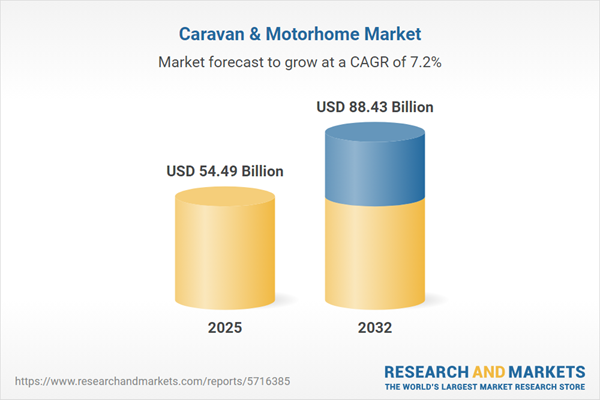Speak directly to the analyst to clarify any post sales queries you may have.
The caravan and motorhome market is undergoing significant evolution as new technologies and changing consumer lifestyles reshape stakeholder strategies. Businesses across the value chain must navigate shifting demands, supply chain volatility, and regulatory pressures to capitalize on emerging opportunities and stay competitive.
Market Snapshot: Caravan and Motorhome Market Growth and Dynamics
The global caravan and motorhome market expanded from USD 50.87 billion in 2024 to USD 54.49 billion in 2025. Sustained at a CAGR of 7.15%, the market is projected to reach USD 88.43 billion by 2032. Consistent growth is driven by rising interest in mobile lifestyles, integrated digital solutions, and the pursuit of travel independence across established and emerging regions.
Scope & Segmentation of the Caravan and Motorhome Market
This report offers detailed coverage on market segments, regional diversification, and core technology trends shaping sector performance.
- Vehicle Types: Caravan (Conventional, Fifth Wheel, Pop-Up Trailer); Motorhome (Class A, Class B, Class C)
- Price Range: Economy, Mid Range, Luxury
- Length: Less Than 5M, 5 To 7M, Greater Than 7M
- Powertrain Options: Diesel, Gasoline, Electric
- End Users: Commercial, Leisure, Rental
- Distribution Channels: Dealership, Direct Sales, Online
- Sleeping Capacity Configurations: 2 Persons, 4 Persons, 6+ Persons
- Chassis Types: Integrated, Semi Integrated, Van Conversion
- Regions: Americas (North America, Latin America), Europe, Middle East & Africa, Asia-Pacific
- Key Companies Covered: Thor Industries, Forest River, Winnebago Industries, REV Group, Jayco, Groupe Trigano, Erwin Hymer Group, Knaus Tabbert, Adria Mobil, Pilote SAS
Key Takeaways for Senior Decision-Makers
- Advancements in digital connectivity and modular design are redefining the value proposition for both buyers and suppliers, emphasizing integrated telematics and sustainable materials.
- Consumer demand is increasingly influenced by demographic shifts—digital nomads seek flexible, self-contained travel, while families value versatile layouts with greater comfort.
- Strategic partnerships across chassis builders, component manufacturers, and software providers support rapid innovation, shorter go-to-market cycles, and differentiated product offerings.
- Regulatory requirements around emissions and resource efficiency are compelling manufacturers to align R&D investments with electrification, renewable energy integration, and recyclability.
- Regional implementation of compact, eco-friendly, and digitally immersive caravans and motorhomes addresses varied regulatory landscapes and consumer preferences across global markets.
- Aftermarket and service ecosystem development is emerging as a growth area supporting customer loyalty and incremental revenue beyond initial sales.
Assessing Tariff Impact: Navigating the United States 2025 Tariff Landscape
New tariff measures in the United States for 2025 are increasing import duties on essential components and chassis, leading to higher production costs and potential wholesale price adjustments. Manufacturers are exploring near-shoring fabrication, renegotiating with tier-one suppliers, and optimizing procurement to mitigate input cost escalation. These strategies, along with value-added offerings, aim to support margin protection and maintain competitive positioning despite the evolving tariff environment.
Technological, Environmental, and Lifestyle Transitions Shaping the Sector
Rapid adoption of digital innovations—such as IoT integration, advanced telematics, and electrified auxiliary systems—is enhancing the connected vehicle experience. Simultaneously, moves to embed circular-economy principles and environmentally responsible manufacturing processes are becoming fundamental, especially as regulatory mandates intensify globally. Demand for modular interiors, scalable amenities, and off-grid capabilities meets the needs of both younger digital professionals and seasoned travelers, cementing a trend towards customizable, tech-integrated living spaces on wheels.
Methodology & Data Sources
The research employs a mixed-methodology approach—qualitative interviews with senior leaders, surveys targeting end users and fleet operators, and thorough triangulation with industry reports and regulatory filings. Analyses are refined using recognized frameworks such as SWOT, Porter’s Five Forces, and scenario mapping, ensuring actionable and transparent market insights.
Why This Report Matters for Caravan and Motorhome Stakeholders
- Provides actionable benchmarks to guide investments, portfolio development, and channel strategies across a rapidly shifting sector.
- Enables leaders to proactively address emerging regulatory, technological, and demographic challenges by aligning R&D, procurement, and go-to-market models.
- Empowers better decision-making by clarifying the implications of global tariff shifts, supply chain resilience imperatives, and consumer lifestyle transformations.
Conclusion
Senior decision-makers benefit from a detailed analysis of trends, risks, and innovation pathways influencing the caravan and motorhome market. This report supports the formulation of resilient strategies and highlights opportunities for sustainable growth in an evolving industry.
Additional Product Information:
- Purchase of this report includes 1 year online access with quarterly updates.
- This report can be updated on request. Please contact our Customer Experience team using the Ask a Question widget on our website.
Table of Contents
3. Executive Summary
4. Market Overview
7. Cumulative Impact of Artificial Intelligence 2025
Companies Mentioned
The companies profiled in this Caravan & Motorhome market report include:- Thor Industries, Inc.
- Forest River, Inc.
- Winnebago Industries, Inc.
- REV Group, Inc.
- Jayco, Inc.
- Groupe Trigano SA
- Erwin Hymer Group GmbH & Co. KG
- Knaus Tabbert AG
- Adria Mobil d.o.o.
- Pilote SAS
Table Information
| Report Attribute | Details |
|---|---|
| No. of Pages | 187 |
| Published | October 2025 |
| Forecast Period | 2025 - 2032 |
| Estimated Market Value ( USD | $ 54.49 Billion |
| Forecasted Market Value ( USD | $ 88.43 Billion |
| Compound Annual Growth Rate | 7.1% |
| Regions Covered | Global |
| No. of Companies Mentioned | 11 |









